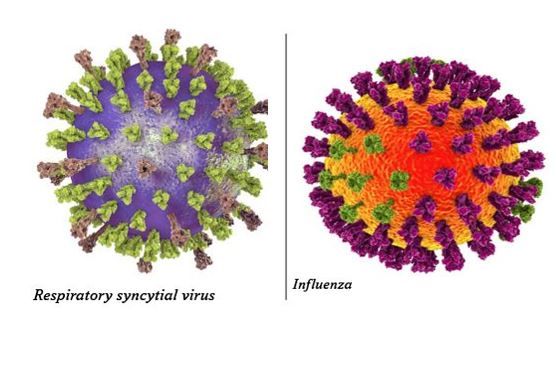- Clinical Technology
- Adult Immunization
- Hepatology
- Pediatric Immunization
- Screening
- Psychiatry
- Allergy
- Women's Health
- Cardiology
- Pediatrics
- Dermatology
- Endocrinology
- Pain Management
- Gastroenterology
- Infectious Disease
- Obesity Medicine
- Rheumatology
- Nephrology
- Neurology
- Pulmonology
RSV Mortality Higher than for Influenza B 90 Days After Hospital Discharge: New Data
Older adults hospitalized with RSV were older, more frail, and more likely to have respiratory comorbidities than those with influenza A or B, the study found.
Older adults hospitalized with respiratory syncytial virus (RSV) infection were at more than 2 times greater risk of mortality within 90 days of discharge than those admitted with influenza B, and at similar risk to those with influenza A, according to a team of Danish researchers.1
©Kateryna_Kon/stock.adobe.com

Adults with RSV were more likely to have chronic cardiopulmonary conditions upon hospital admission and more likely to have pneumonia than those with either influenza A or B. The researchers also found that individuals hospitalized with RSV infection and influenza B were slightly older than those with influenza A. Both increasing age and having pneumonia were identified as independent risk factors for 90-day mortality among those with RSV.
“Historically, RSV infection has not been regarded as severe a disease in adults as influenza, leading to inconsistent testing strategies for RSV,” co-first author Clara Ludnetoft Clausen, Center of Research and Disruption of Infectious Diseases, Amager and Hvidovre Hospital, Denmark, and colleagues wrote. “Our findings contribute to the mounting evidence suggesting that hospitalizations with RSV infections can be equally, if not more severe and deadly, than influenza, especially among older and frail populations.” They added that the study’s data underscore the need for better vaccination and testing strategies and targeted treatments, including trials of antiviral medications.1
The investigators cite data from the US that show that hospitalization for RSV is less frequent than for influenza, but that the severity of the infection is comparable to if not more severe than influenza.2 US investigators have emphasized that the potential for more severe disease and worse outcomes in the older population should be considered during shared decision making conversations to assess the benefit of RSV vaccination among adults aged ≥60 years.2 There are limited data, however, related to RSV-associated hospitalizations “within the European continent,” the authors wrote, hampering policymaking efforts when considering in-hospital testing and RSV vaccination strategies in those countries.1
Clausen and colleagues designed the current research to better understand the clinical characteristics and manifestations of individuals hospitalized with RSV compared with influenza A/B, to evaluate the differences in disease severity and mortality among the 3 groups, and to identify risk factors for mortality.
The multicenter, retrospective cohort study included individuals hospitalized with RSV, influenza A or influenza B at 3 large Danish hospitals between March 2016 and April 2020. Inclusion required age of 18 years or older with a positive test for one of the viruses within 48 hours of hospital admission and hospitalization for at least 12 hours. Any cases of dual or triple infection with the 3 viruses were excluded.1
FINDINGS
The final cohort numbered 988 of whom 36% (353) were hospitalized with RSV, 35% (347) with influenza A, and 29% (288) with influenza B. Approximately one-half were women and median age was 74 years among those with RSV, 69 years for those with influenza A, and 73 years for those with influenza B.
Clausen et al reported a significantly greater proportion of those infected with RSV died within 90 days of hospital discharge (17%) than with influenza A (9%, P =.005) or B (8%, P =.001). Mortality was similar when restricted to only those with pneumonia.
The unadjusted odds (OR) of mortality within 90 days of hospital discharge were twice as high for RSV compared with both influenza A (OR 2.06, 95% CI 1.30-3.25; P =.002) and influenza B (OR 2.53, 95% CI 1.51-4.23; P <.001). However, after adjustment for covariates the association remained significantly higher for influenza B (OR 2.16, 95% CI 1.2-3.87; P =.010), but not for influenza A (OR 1.38, 95% CI 0.084-2.29; P= .207).
The researchers reported no differences in the proportion of study participants admitted to the intensive care unit and a similar number from the 3 groups died during hospitalization.
Nearly one-third of the individuals infected with RSV had treatment restrictions during hospitalization, ie, limiting ICU admission and cardiac resuscitation, suggesting the level of frailty of this subgroup. In fact, in their sensitivity analysis who et al found that increased mortality risk in participants with RSV was “mainly driven by individuals subject to treatment restrictions.”
Pneumonia was detected in almost half of the patients with RSV (41%), compared to a third of patients with influenza A and B (29% and 24%, respectively), according to the study. Mortality was higher among individuals with RSV and pneumonia than among those with influenza and pneumonia but remained higher for those with RSV after adjusting for pneumonia.
"Older adults hospitalized with RSV infections are at a higher risk of dying within 90 days of hospitalization than patients admitted with influenza B, but similar to those admitted with influenza A, emphasizing the detrimental effects and severity of older patients being infected with RSV," the researchers concluded. "Our findings underscore the need for strategic testing and vaccination approaches to mitigate the impact of RSV among older adults."
